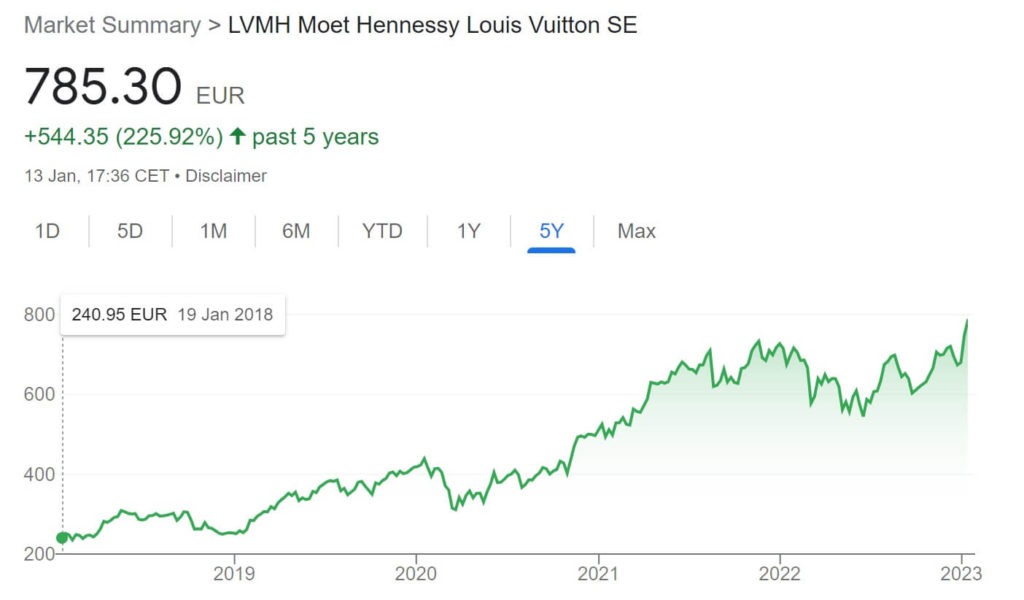As the baton was handed over from Bernard Arnault, the head of Luxury brand LVMH, and now holder of the title of the world’s richest man, to his daughter Delphine Arnault as head of Dior, her first order of business, and most exigent, is not curating demand; it’s keeping pace with it.
While headlines may be brimming with tails of economic woe, luxury food and beverage retailers say their biggest headache is not a lack of clientele, but an abundance, even to the point that Philippe Schaus, chief executive of Moët Hennessy had serious concerns that stocks in the 17 miles of underground cellars under the town of Epernay in France’s Champagne region were running dangerously low in the run up to Christmas 2022.
Fortunately, disaster was narrowly averted and both Christmas and NYE could be celebrated with a glass of the region’s signature produce in hand, but this didn’t mean the 280-year-old brand could take a moments respite. Far from it, market indicators show that the global appetite for the DeFacto celebratory drink are only set to increase in 2023 – it seems the roaring 20’s are in full swing (no pun intended).
Commenters prophesied history would repeat itself and we would witness a second ‘roaring twenties’, an era characterised by extravagance and a penchant for luxury following restrictions on normal daily life caused by global events such as war and pandemic.
The LVHM brand which includes Moët, Louis Vuitton, and Dior has seen its stock price double since the start of the pandemic and get off to a strong start in 2023. It would appear the demand for luxury is very much present, and the predictions accurate.

Most restaurateurs would be hard pressed to deny that January, the post festive season is the most challenging, and opening a new venue during this period would just be courting financial disaster. Yet Caviar Kaspia, who have just opened a new venue on Melrose Place in LA don’t seem overly concerned; already with an evening service waitlist, their confidence appears well deserved.
Over in London, England, two-Michelin starred restaurant Ikoyi has just moved to new premises for a January opening. Despite record high energy prices in Europe with some businesses reporting monthly electricity bills of £10,000 ($12,250), owners Jeremy Chan and Iré Hassan-Odukale seem equally confident they won’t struggle to get diners through the doors to experience their £300 ($370) tasting menu.
Producers of Caviar, the delicacy that is often used as a garnish and retails from around $50 to $3,000 per ounce, and as much as $16,000 per pound when derived from wild Iranian albino Beluga sturgeons, have also seen an uptick in demand recently.
One of Uruguay’s largest producers of Caviar Polanco doubled production last year to 6.5 metric tons and is planning on further increasing production in 2027 to thirteen million metric tons.
In the United Kingdom one of the major producers of Caviar, Exmoor Caviar ran out of stock in 2020, they now have plans to start producing cell-cultivated caviar in 2023 to meet the ever-rising pressure on supplies of a delicacy which is painfully slow to harvest.
While some of these increases could be pinned on the fact that imports of Russian Caviar have been banned, the crux of the issue is that there just isn’t enough of these expensive salty little fish eggs to keep every restaurant diner satisfied.
If you’re a fan of truffles, the elusive fungi that can turn a mediocre pasta dish into something which makes your taste buds fire on all cylinders, there is both good and bad news. The good news is, what Bloomberg termed ‘The Great White Truffle Crisis of 2021’ was due to climatic circumstances and not supply outstripping demand.
The bad news, as anyone who has just returned from a vacation on one of the popular European ski slopes can attest to, is it’s getting warmer, which does not bode well for truffles which are essentially ‘foraged’ and almost impossible to farm.
While there currently isn’t a shortage of truffles, this finite ingredient is at risk of disappearing from restaurant menus if demand increases only slightly.
Data from a new study by Bain & Company indicates that the luxury market, which includes fine wines and spirits, gourmet food and fine dining, will be more resilient to recession in 2023 than 2009 and that it experienced an 8%–10% growth in 2022 compared to 2019.
After two years of anxiety for purveyors of fine foods caused by the global pandemic, they now face a new challenge; satisfying the pent-up gastronomical cravings of a group of people who have been denied dining out for two years and have even more disposable income than before they donned a face mask.
